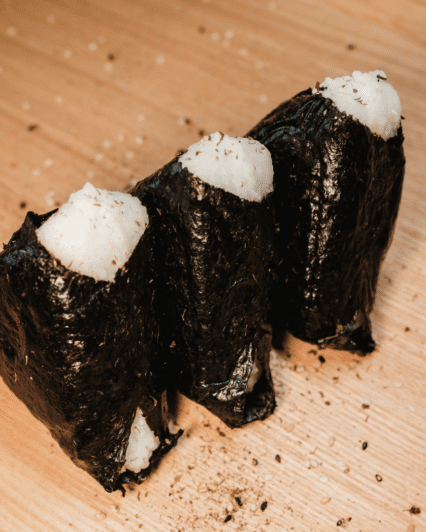About the 8 Different Types of Japanese Seaweed

About the 8 Different Types of Japanese Seaweed
Different types of seaweed have different flavors, textures, and properties and thus are better-suited towards different culinary uses. Yet they all have a common flavorful “sea” taste, and all are high in a bunch of different minerals and vitamins.
Here’s eight of our favorite Japanese seaweeds and how they can make your kitchen rule.
Nori
Nori is probably the best known seaweed in the US — if you’re not familiar with the many types of seaweed used in Japanese cooking, then nori is probably the one that comes to mind when someone mentions seaweed as something edible.
It comes from pyropia, a type of red algae, but nori is not red but rather dark green. You’ll typically find it at the supermarket in thin sheets that are somewhat crispy. This is from the drying process after harvesting. Unlike some seaweed varieties, nori isn’t smooth but has a moderately coarse texture.
Meanwhile, the flavor is milder than most seaweeds; it’s a bit salty from the sea and naturally has a hint of minerality, but it’s less potent than other varieties.
It’s famously used in sushi, but you can also shred it as a garnish or use it to wrap other foods like onigiri.
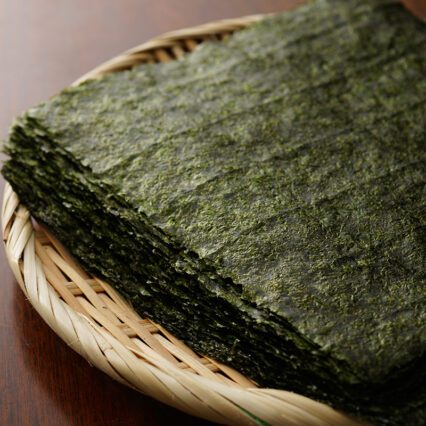

Kombu
Unlike nori, kombu is thicker, smoother, and stronger in flavor. That’s because kombu comes from kelp, which is generally hardier than red algae.
Because kombu is so hardy and thick, it itself isn’t usually eaten — or on the rare occasions you do eat it, it must be cooked for a very long time first or pickled or shaved very thin. When not taking steps to make it edible by itself though, it’s primarily used to make other foods more flavorful, most famously dashi.
Dashi is a broth that’s the backbone of countless Japanese dishes. It’s not just used in soups, but also in place of water in doughs and batters to impart more flavor, like in okonomiyaki, the Japanese savory cabbage “pancake.” One of its main ingredients is kombu which, along with bonito, is key to creating the earthy, rich umami flavor.

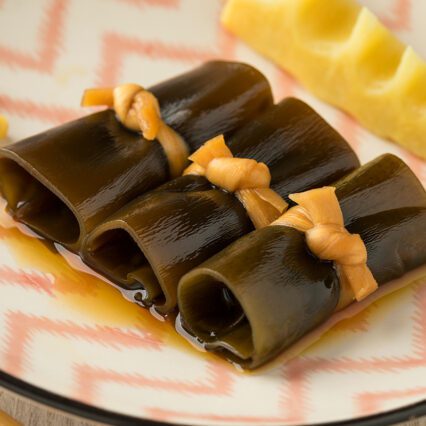
Aonori
Resist the urge to conflate aonori and nori — they’re not the same.
While nori usually is found in dried sheets, aonori usually comes in smaller dried flakes or coarsely powdered. Predictably, it’s then not used to wrap other foods like nori so often is but is common as a seasoning or garnish. Aonori is commonly used to garnish yakisoba, okonomiyaki and takoyaki and is an essential ingredient for furikake.
Like other seaweeds, it adds more dimensions to dishes. When used during the cooking of other foods like stir fries, it imparts a mild umami, while as a garnish it adds a bit more depth of flavor and a pleasant texture.

Hijiki
Popular in certain Japanese and Korean dishes, hijiki is probably the most visually distinct seaweed of the ones we’ve mentioned so far. It comes in green-tinted dark brown strands or shorter stringy bits that could look at a glance like tea. You won’t find yourself confusing hijiki with nori, needless to say.
Hijiki is dried during its processing, so before cooking you’ll generally have to soak it briefly in water — about a half hour is usually right.
From there, it’s popular in salads, stir fries, soups, and rice dishes, to which it adds a satisfying texture and flavor.
Nutritionally, hijiki is like other seaweeds in that it has a high fiber content alongside many minerals and vitamins. It is worth noting that North American food agencies have found hijiki to be more susceptible to absorbing arsenic than other seaweeds, but the corresponding Japanese agencies have disputed the danger of this amount unless one were to eat a whole bunch of it.
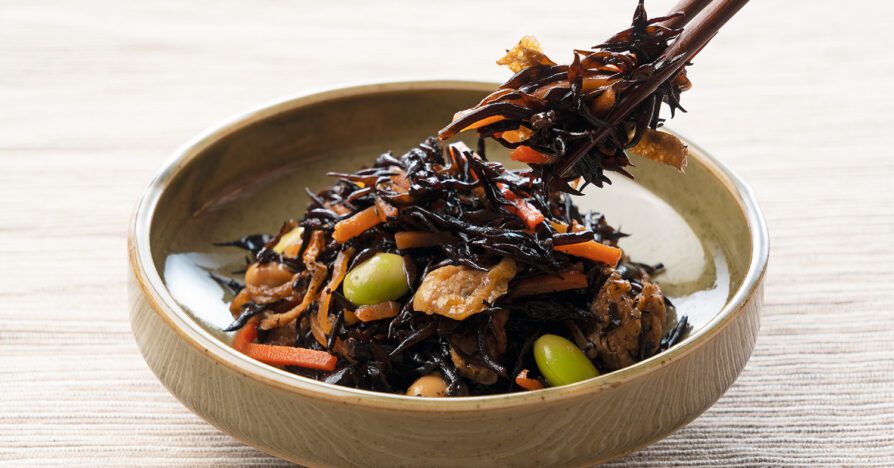
Wakame
If you saw it out of the corner of your eye, you might mistake wakame for a leafy green above-ground vegetable; it’s brighter than most other seaweeds — especially when prepared certain ways — and has a relatively smooth texture.
Wakame has a pretty mild flavor in comparison to many seaweeds. It still has a bit of “sea” taste, but it’s more refreshing than pungent. It also has a texture that’s kind of like a more delicate kombu — similarly slippery and smooth, but more tender (and of course not so thick and fibrous that it’s beyond edibility).
For these reasons, wakame is popularly used to make wakame salad, often sprinkled with sesame seeds. It’s also often added to miso soup; when you see the little specks of dark seaweed floating around the broth alongside the soft tofu, what you’re usually looking at is wakame.
When cooking with wakame, you generally should soak it for a few minutes before cooking. You can also blanch it, which is what leads to the especially vibrant, vivid green that you see sometimes.
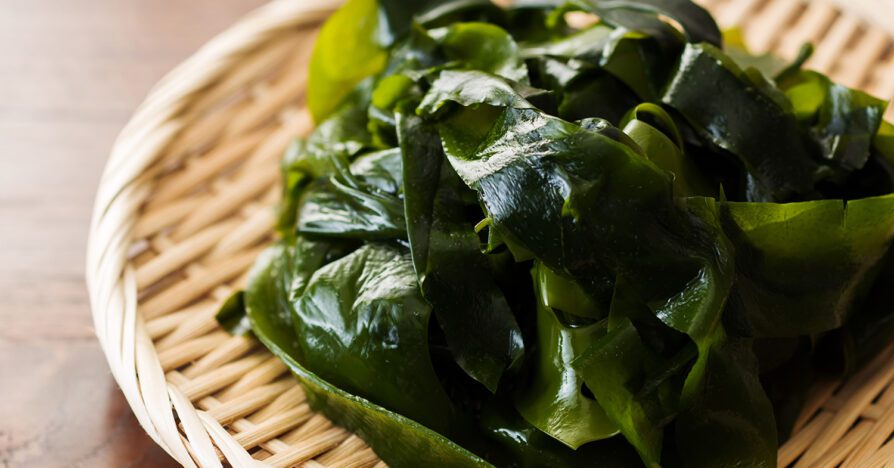
Ogo
Ogo comes in thin strands. Like most other seaweeds, it’s a bit salty, but it’s also lighter than most other varieties. It also stands out for being a brown-ish red color when raw.
Popular uses for ogo include raw or cooked in salads, soups, and alongside other seafoods to freshen up the other components of a dish. Beyond Japan, it’s also common in Hawaiian dishes, most famously in poke. And when cooked, ogo’s red-brown hue gives way to a slightly green brown.
Beyond these conventional culinary uses, ogo also is the source of agar-agar, which is a vegetarian source of gelatin!
Mekabu
So, this is technically cheating because mekabu is actually derived from wakame seaweed, which we mentioned earlier. It’s the sprout of the wakame that, when harvested, looks crinkled and quite distinct.
It can be found in dried or fresh form and has various culinary uses including in salads or soups like udon. Generally, it’s eaten more as a condiment than primary ingredient.
Mekabu also has the distinction of being used in beauty products, including shampoo and skin creams.
Mozuku
Lastly is mozuku. This is a type of stringy algae that’s almost like a thin seaweed noodle.
Mozuku’s texture is somewhat slimy but satisfying and delicious! Its flavor is on the milder side but still with the hint of sea freshness and umami.
It’s popular pickled but also hot in soups or noodle dishes — and even fried in tempura. Mozuku also contains the fiber alginic acid (also found in mekabu) along with many other nutrients.
A wealth of vitamins and minerals is one of the common qualities of all seaweeds. While they each bring different tastes, textures, and uses, these all add a delicious mineral savory-ness to foods and help you maintain a nutritionally rich diet. Experiment with them in your cooking and see which you like the most!




